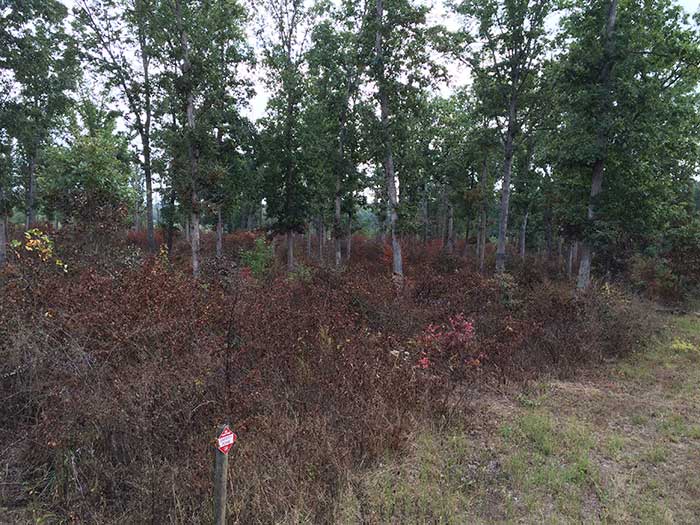
this will burn far differently than a similar situation in spring long after leaf drop
Photo by Marc Puckett
As creatures of habit, we tend to do things in cycles or patterns that are comfortable to us. After all, doing things at certain times in familiar ways minimizes stress. Prescribed fire can be stressful, especially for the burn bosses. It is also hard to flip a switch from the annual fall activities of disking in sunflowers and planting winter wheat and mowing roads and trails in preparation for hunting season, instantly to fire lines, equipment readiness and burn planning. Thus, in many cases most prescribed fire, whether being done by wildlife agencies, or NGOs or even private landowners is conducted in late winter and early spring. It is a timing that just seems to fit like a good seasoned, drip torch fuel laced fire glove.
But fall offers a fantastic chance to accomplish some #goodfire, too. Hardwood saplings are beginning to think about sending a lot of their energy down into their root systems for winter. This means if you can top kill them and prevent a lot of that energy from making it down into the ground, you have a good chance of eliminating that sapling…which in the case of early-successional species management is what you want…fewer saplings and more herbaceous growth (in some but not all cases – the subtle differences between quail versus grouse or woodcock management, the latter two benefitting from saplings).
There are some similarities between spring and fall fire…and some differences. Consider the summer solstice of June 20th – the longest day of the year. By September 20th, day length is the same as it would have been on March 20th (the math is simple 90 days plus or minus from the summer solstice, using 120 days, October 20th compares to February 20th). And both seasons will have numerous days that are conducive to inversions in the evenings, as the days warm, but rapidly cool near and after dark, causing residual smoke to settle. Both seasons also tend to have a series of cold fronts moving through every few weeks, each with substantial winds at times, though more so in March than in September. Fire weather can be volatile during both spring and fall.
There are some differences worth considering, too. In early spring hardwood forest canopies have not closed, offering good ventilation. And fuel has been matted and compacted from winter rain and snows, which is true in pine stands, too, though rapid drying occurs in spring with higher temperatures, low humidity, and wind. In fall, a hardwood understory may be fresh with newly fallen, dried leaves, ripe for fire. This is especially true for fire adapted species like southern red, white and chestnut oaks. And those small saplings that were bare of leaves in spring, or perhaps with a few small new green sprouts now may have substantial leaf loads – meaning some degree of ladder fuel exists, and perhaps a more volatile fuel source. Countering that will be the shade provided close to the ground, and resistance to air movement. It might take more in-stand wind speed in fall to move the fire, than in early spring. So…that exact same unit you planned to burn in spring, with the exact same fire lines, might take some changes in approach during fall.
I am not well versed in fuel models. But I do know what I am seeing in terms of fuels and how it effects fire behavior. You can imagine a burn unit in spring with somewhat matted leaves, or pine needles, being more of a leaf litter fuel type, whereas that same unit in fall, with leaved saplings and fluffy newly fallen leaves on the ground might approach more of a brushy fuels scenario. For those of you who are fire pros, I apologize for my lack of correct terminology.
And what about old fields? In late winter or early spring, the fuels have become somewhat sparse in places, but dead standing native grasses make a great fire carrier. Even a little bare ground in these settings will slow a fire’s spread. The challenge in spring is to get a field burned before it becomes too green to carry a fire effectively. By late summer into fall, many of the summer annuals are dying back, the native grasses are drying out, and fuel loads are heavier. I have been surprised by how well fire spreads in fall field situations even when humidity is 45% or 50%. One point in fall fires favor whether in fields or under woodlands is that ground nesting birds have largely completed their nesting cycles. And as many have pointed out in various papers and presentations, fall fire has a very low risk of causing nest loss, while some risk does exist in spring.
Well… it all boils down to what it always all boils down to…LOL…situational awareness, being able to interpret fuel loads and type and their probability of ignition (which is now available on some Kestrel fire weather units), understanding watch-out situations, planning thoroughly, and using the commonsense you have been blessed with. There is hardly a month of the year when prescribed fire can’t be conducted safely and effectively if the right conditions exist and proper planning is employed. Maybe this fall, you will fall for some fall fire (how many times can the word “fall” be used in one sentence effectively?).




